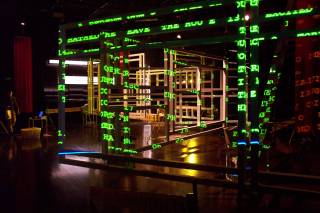
|
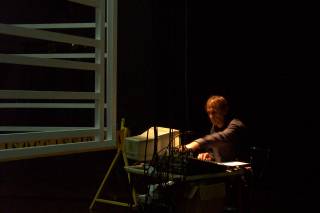
|
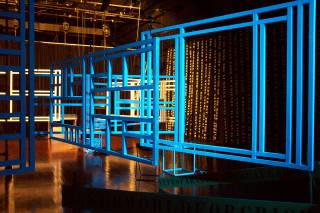
|
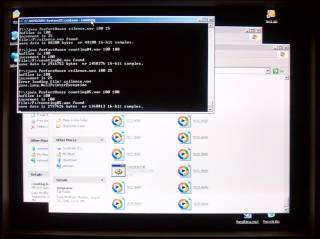
|
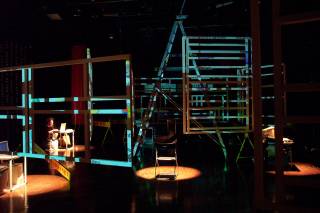
|
Banalities for the Perfect House
Rainer Linz Ruark Lewis
Banalities for the Perfect House is a collaborative installation & performance work premiered at Sydney's Performance Space theatre on Sept 9 2005.The work posits the house as a condition through which we perceive the world - the city an extension of grid-like structures viewed through the frame of an open window.
The performance space is arranged with wooden frames, boards and barricades resembling, in abstract form, a housing construction site. Each surface is rendered with text creating an immersive environment that can literally be read, and heard as speech.
Performance texts are distilled from everyday sources including newspapers, cookery books, and snippets of overheard conversation. They consist of seven Banalities: Banalities for the Perfect House, Banalities for Napoleon, Banalities for the Modern Kitchen, Banalities for Solid Mandala, Banalities for Newspapers, Banalities for the Times and Misreading for Barricades.
The texts are inscribed on all architectural surfaces, and take the form of performance scripts as well. These include cards, looseleaf and bound pages, and word sequences printed on ticker tape. The varied nature of the text surfaces informs the spatial and performative features of the work.
The sound is performed on five computer terminals and projected through a 4-loudspeaker sound system. It is performed using real-time computer processing of original vocal samples, in turn derived from the written texts. The computer sound-generating software was purpose-written for the piece.
The work is built around a series of duet and solo performances. Each is based on an individual text, which is the common basis for both the computer and vocal renditions.
The Perfect House is a construction site for ideas, with performers and audiences traversing it as if through rooms filled with words whose meanings, too, are still under construction.
For critical responses see
http://www.smh.com.au/articles/2005/09/11/1126377204457.html
http://www.realtimearts.net/rt70/brickhill_perfecthouse.html
An interview with Olivia Kurts
OK: Well, what do you guys think about the construction of Avant Garde historical perspective circa 2005Ruark: well you know I'd probably like to move away from that sort unfortunate labelling - for starters, you could say there was and is a tendency existing, an Avant Garde tendency, but it is largely academic and predetermined before actually being practiced in my view. For me I am a social animal, in that I see the application of art as a social obligation, and that being the case, experimentation is a more useful through-line for the way I think and act in the field
Rainer: Im careful not to associate the avant garde too exclusively with twentieth century modernism. Practices that we associate with the Avant Garde in music are documented since before the Renaissance, and I suggest they will be discernible in the music of another 600 years or so - provided the human race survives that long! I see the Avant Garde as something of a human condition, in the sense that we will always have music, and we will always have the Avant Garde.
OK: So why are you participating in the curatorial series "Who's Afraid of the Avant-Garde" in Sydney?
Ruark: I like the word opportunity. For me it more often replaces that of process or problematising things, or locating solutions to what are commonly referred to as 'the problem'. When the TPS curator fronted with his notion for an exhibition, he had certainly fixed on the WAAG title as his banner. I was immediately uncomfortable with it and raised my hand as if answering affirmatively, "Me, I am".
I firstly saw it as an opportunity to make another work in and about Redfern, the academic labelling was not my concern. It's the location that I had almost totally in my sights, but equally, the opportunity to work with Rainer in an expanded way was paramount.
As a preamble I should perhaps outline some trace of events leading towards Banalities for the Perfect House. In the 3Q.03 we had attempted some preliminary explorations around dual performances in Melbourne. In the Builder's Arms Hotel I made a model of potentials. In the artists-run-initiative called Clubs. Rainer & I made an afternoon of performances inside a larger work I installed there called CATSCRADLEFORFITZROY. This was a string construction, a set of drawings and an audio work for improvised contrabass (with Jonathan Jones and Richard Ratajczak).
One chilly Saturday afternoon Rainer set-up the equipment to make our first public performance in that room. Later the same month, at RMIT Cardigan Street, in their beautiful Project Space, we set-up another duality - which featured Rainer's New Listener pieces for computer projection, with our FMFN and various graphics and paintings I had brought with me from Sydney. What was formed was an environment or a 'listening room". We equally divided the sensory sources and hierarchies in that chamber work. We were testing how this affected those who experienced such a domain, and how they came to be aware of that space's nature (introduced).
Rainer: In fact our work together started much earlier in the publishing field, through NMA Publications. That was later followed by the cooperative and performance pieces that Ruark mentioned before. In my view the one closest to Perfect House is Banalities for Babel, in that many of the sound and performance ideas for Perfect House were prototyped there.
I tried in those cooperations to render the text 'true to form' as it were. This is something I have always tried to do when working with texts. Only here I was informed by methods to do with translation, or transcription, or rubbing. I suppose there are many ways to describe this process of articulating an underlying form through transcription. Rendering is how I understood the earlier work.
OK: So the work has its own history, and antecedents
Rainer: Not just in our cooperations, but individually as well. In Ruark's case if I may say, the texts are directly connected to his previous work (the other Banalities texts). Meanwhile the frames or grids of the Perfect House extend directly from his research at the Museum of South Australia nearly 15 years ago.
For myself I have always been interested in texts for their form-creating potential, that is, how they might play out in time irrespective of any narrative content. As I see it, these are all straight and simple connections leading to this piece.
Ruark: There are many vagaries too. How a work begins to orbit. That central thought about houses. That there is a vertical and horizontal aspect in the built world that adds up in stories literally. We may have tried to adopt an indigenous modelling of our theatre space. To see if we can look through it in a less territorial way.
I have thought that windows and doors since colonial times, divided us into frames. In this way the frame crucifies the landscape on the inside and outside of one's mind. Or perhaps specifically wandering around Castlecrag, where Marion Mahoney & Walter Burley-Griffin introduced an organic template to that landscape when they built.
We didn't set out to make-up a set of quotes from favoured sources. We hoped to get an overall feeling for associated subject matter. These interests then coloured things. We went onto the amphitheatre called The Haven on the Bulwark. It was surprising to walk onto an outdoor theatre modelled on the ancient principles, with the sight-lines, sound-lines all perfect and framed by the liquidity of the pink-orange angophoras.
Another building Rainer and I examined was the 1950s experimental dwelling known as The Glasshouse designed by Bill Lucas. This has some of the qualities that appeared later in the theatre. Its a see-through house. Close to the roadway, but screened effectively by trees and bushes. This building is interesting, I think of it as an intestinal design, because there is a central courtyard elevated off a rock ledge. is is surrounded by an internal corridor, inturn surrounded by the rooms. These are closed-in with glass walls, and surrounded by an external apron of timber verandas, and eaves.
A very ordered layering of linear forms that allows the dweller to read through, anticipate and sense the world they are occupying. (there is now attempt to translate/transcribe these fine examples to manifest as perfection - in fact the distance between 'perfect' space and...
OK: so you're interested in various places, sounds? Or, when does the abstraction overtake the referential
Rainer: Once the references become "critically intangible". I'm suggesting a sliding scale of tangibility here I suppose, determined by context. I mean you could also ask, when does a wooden frame suspended from the ceiling become a perfect house?
As for the sound, apart from some references to passing time ("technically they are called pips") the entire sound construction is derived not just from the voice, but from Ruark's voice. In other words the starting point is a recording, of Ruark reading the Banalities texts.
So the vocal and computer sound performances share a common source, but display different characteristics as the piece unfolds. This gamut of sound then, like every other aspect of the piece, can be understood as a multifaceted rendering of text. With this in mind I'd characterise the sound as innately vocal and to varying degrees, intelligible.
Audio excerpt 1
from
A Babel Reading Machine
(Banalities for Babel 2005). mp3 (100kB)
Audio excerpt 2
from the
Barricade Dance
(Banalities for the Perfect House 2005). 1'45' mp3 (1.2MB) Excerpt from a live
recording made by Stephen Adams for the ABC.
Used with kind permission.
performance © Rainer Linz and Ruark Lewis 2005.
for comments or feedback